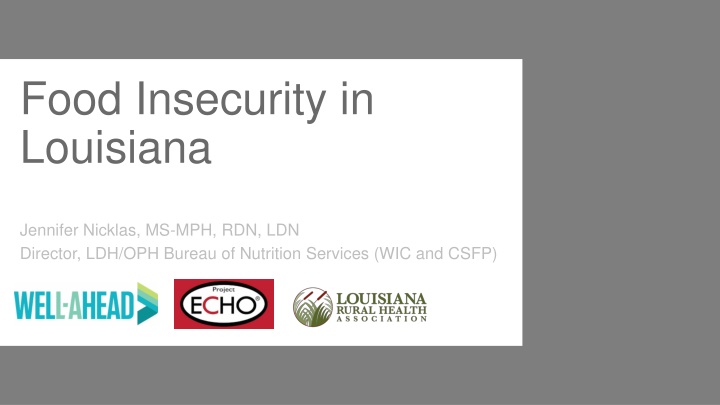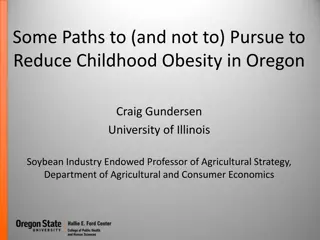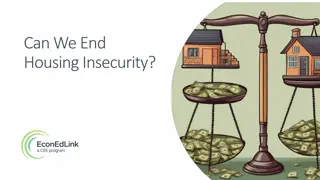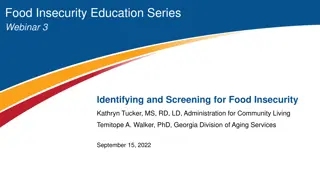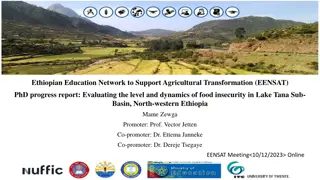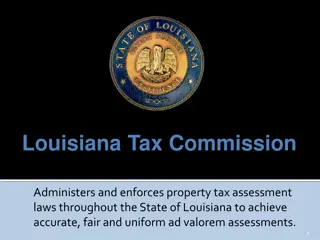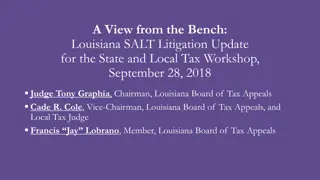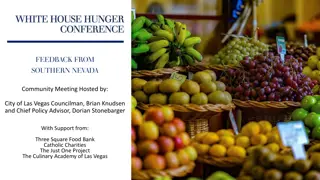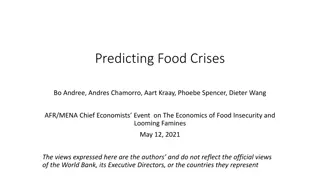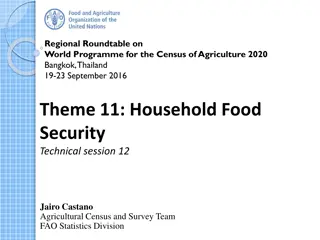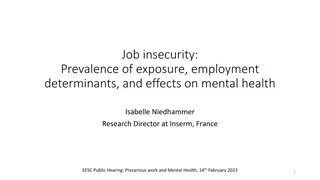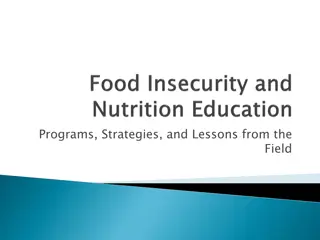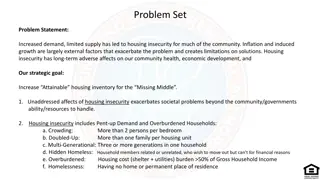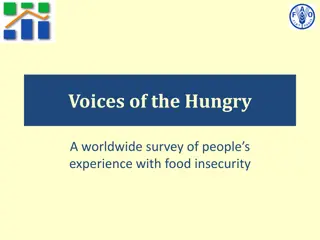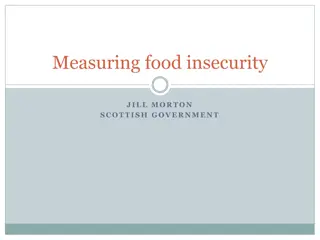Food Insecurity in Louisiana: Statistics and Programs
This overview highlights the concerning rates of food insecurity in Louisiana, particularly in rural areas, impacting children and seniors. It explores federal feeding programs like WIC and CSFP that aim to provide support and nutrition to vulnerable populations in the state.
Download Presentation

Please find below an Image/Link to download the presentation.
The content on the website is provided AS IS for your information and personal use only. It may not be sold, licensed, or shared on other websites without obtaining consent from the author.If you encounter any issues during the download, it is possible that the publisher has removed the file from their server.
You are allowed to download the files provided on this website for personal or commercial use, subject to the condition that they are used lawfully. All files are the property of their respective owners.
The content on the website is provided AS IS for your information and personal use only. It may not be sold, licensed, or shared on other websites without obtaining consent from the author.
E N D
Presentation Transcript
Food Insecurity in Louisiana Jennifer Nicklas, MS-MPH, RDN, LDN Director, LDH/OPH Bureau of Nutrition Services (WIC and CSFP)
Food Insecurity in Louisiana In 2020, it was reported that Louisiana has the 3rdhighest food insecurity rate (15.8%) National Average is 10.5% The Agenda for Children estimated in 2020 that 24% of Louisiana s children live in poverty This results in the 2ndhighest rate of childhood hunger in the US Louisiana ranks in the top 5 for having the highest senior food insecurity at 9.9% New Orleans-Metairie area had the highest rate of senior food insecurity
Food Insecurity in Louisiana Food insecurity is most prevalent in rural areas of our state Often live far away from grocery stores and food pantries (food deserts) Lack of public transportation Jobs often pay lower wages and do not offer full-time hours In the US, 9 out of 10 counties (parishes) with the highest food insecurity rates are rural *Orange dots represent locations of Food Banks; Source: Feeding America
Special Supplemental Nutrition Program for Women, Infants and Children (WIC) Funded by: United States Department of Agriculture (USDA) Food and Nutrition Service (FNS) State Agency: Louisiana Department of Health (LDH) Office of Public Health (OPH) Bureau of Nutrition Services Average Monthly Participation: 94,640 (calendar year 2023) Serves: pregnant, breastfeeding and post-partum women, infants and children up to 5 years of age who are at or below 185% of the federal poverty line Provides nutrient dense food packages based on nutritional risks, nutrition education, and breastfeeding support
Commodity Supplemental Food Program (CSFP) Funded by: USDA FNS State Agency: LDH OPH Bureau of Nutrition Services Average Monthly Participation: 38,076 (calendar year 2023) Serves: seniors (60 years or older) living below 130% of the federal poverty line Provides nutritious food boxes to seniors monthly, in addition to nutrition education and referrals to other programs and services
Supplemental Nutrition Assistance Program (SNAP) Funded by: USDA FNS State Agency: Department of Children and Family Services (DCFS) Division of Family Services Average Monthly Participation: 864,775 recipients/month (state fiscal year 2020) Serves: households who meet specific income guidelines Provides monthly benefits on an EBT card that help eligible households purchase the food they need for good health
National School Lunch Program (NSLP) Funded by: USDA FNS State Agency: Louisiana Department of Education (LDOE) Average Monthly Participation: 8,772,000 lunches/month (state fiscal year 2020) Serves: children 5-18 years of age Provides nutritionally balanced, low-cost or free lunches to children each school day School Breakfast Program (SBP) also administered by LDOE
Child and Adult Care Food Program (CACFP) At Risk Afterschool Meals Funded by: USDA FNS State Agency: Louisiana Department of Education (LDOE) Average Monthly Participation: 120,000 lunches or snacks/month (calendar year 2021) Serves: children 0-18 years of age Provides meals and snacks to infants, children, teens, and adults in a variety of care settings, including afterschool care programs
Child and Adult Care Food Program (CACFP) - Daycares Funded by: USDA FNS State Agency: Louisiana Department of Education (LDOE) Average Monthly Participation: 496,000 lunches/month (state fiscal year 2020) Serves: children 0-5 years of age Provides meals and snacks to infants and children in an established daycare or daycare home setting
Summer Food Service Program (SFSP) Funded by: USDA FNS State Agency: Louisiana Department of Education Average Monthly Participation: 211,000 lunches served/month (state fiscal year 2020) Serves: children 0-18 years of age Provides free meals to children and teens in low-income areas during the summer months when school is not in session
The Emergency Feeding Assistance Program (TEFAP) Funded by: USDA FNS State Agency: Louisiana Department of Agriculture and Forestry (LDAF) Average Monthly Participation: 220,534 individuals/month (federal fiscal year 2021) Serves: households under 130% of federal poverty line Provides emergency food assistance at no cost to low-income individuals Foods given to local food banks or soup kitchens who in turn distribute to the public
Food Banks in Louisiana In 2021, Louisiana Foodbanks distributed 117.6 million pounds of food Equates to enough food to prepare 98 million meals The food bank network includes partnerships with nearly 1,000 community- and faith-based organizations statewide
Call to Action What can rural healthcare providers do? Screen for food insecurity at each visit Food is a physiological need that should be considered when treating and working with individuals and families Universal screening tools for food insecurity are available Stay up-to-date and aware of programs and resources available in and for your community Make referrals to available resources and programs based on need and potential eligibility
Questions? Jennifer Nicklas, MS-MPH, RDN, LDN Director, Bureau of Nutrition Services Programs: Louisiana WIC and CSFP Jennifer.Nicklas@la.gov | 225-342-7988
